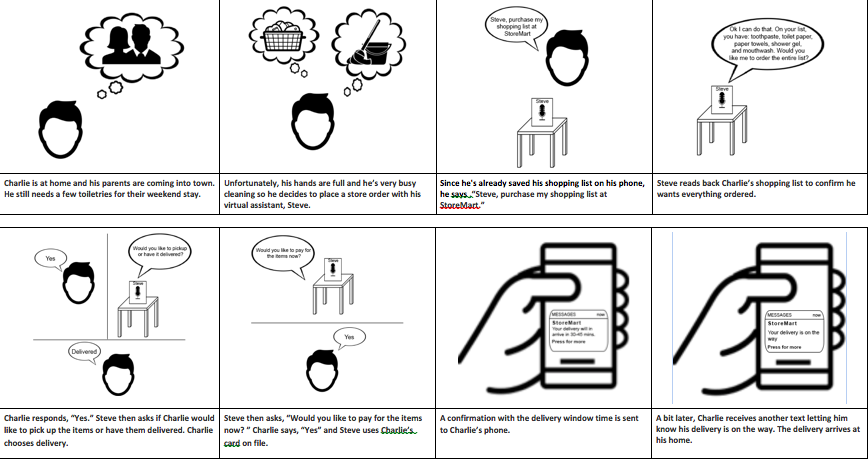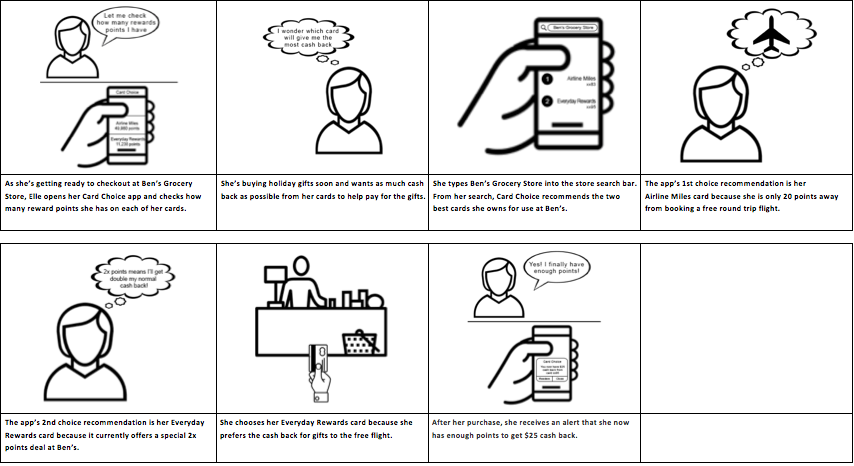Fintech Envisioning
FIRST DATA INNOVATION LAB | 2016-2017
This exploratory project aims to understand what consumers consider “necessity spending” when it comes to their financial habits.
Project Overview
Title: Fintech Envisioning (Necessity Spending)
My Role: UX (Design & Research) Lead
Team: Product Manager
Duration: 4 months
Impact: Advised leadership on technology and product opportunities through market gap analysis and storyboards, while providing thought leadership on consumer behavior across multi-device shopping journeys
Context & Problem Definiton
Background: We hypothesize that people view routine necessity spending as obligatory, so they overlook pain points in these shopping experiences despite room for improvement.
Target Users: Everyday consumers and shoppers
Problem Statement: How do people define necessities, and how can we improve how they shop for them?
Constraints: Finding a variety of local consumers to interview
Research & Discovery
Methods: Survey, Literature Review, & In-Person Interviews
Key Insights: Most people define their “necessity spending” as shopping related to food
Impact on Direction: Allowed me to pick a theme for concepts to explore
Phase 1: Survey to understand the current space
I created a survey and gathered 50+ responses from friends, family, and acquaintances to inform our research
Phase 2: Literature Review
To explore tech use in shopping habits and survey trends, I reviewed 25 articles
Phase 3: In-person Interviews
I created a screener and partnered with a recruiting agency to conduct in-home interviews across diverse demographics. Discussing money in a familiar setting encouraged openness, while my product manager captured notes
Ideation & Design Process
After defining categories and technologies, I refined storyboards with my team for clarity and tested final versions in 10 in-person interviews.
Shopping With a Virtual Assistant
Insight: Grocery delivery is convenient and customers are willing to pay a premium for it.
Choosing the “Best” Card For Purchases
Insight: Customers often choose credit cards based on limits, interest rates, or account history—rather than simply maximizing reward points.
Hands Free Ordering in Your Car
Insight: Customers see mobile ordering as convenient for on-the-go use, but question whether it’s truly faster than a drive-thru.
Reordering Items
Insight: Customers struggle to remember essential items, since stocking up often leaves them unprepared when supplies unexpectedly run out.
Self Scan at Grocery Store
Insight: Customers value self-checkout for the control it gives them, but lines often move slower since shoppers can’t bag as quickly as clerks.
Rerouting to a Nearby Store
Insight: Customers find voice-activated GPS valuable for rerouting on the go without texting and driving.
Conclusion
We found food to be the largest necessity expense beyond recurring bills. If taken beyond prototyping, we’d focus on solutions for fast food, grocery, and restaurant purchases.
During the interviews, we asked participants to rank each storyboard concept by most to least beneficial to their current necessity spending.
Self Scan at Grocery Store
Choosing the “Best” Card for Purchases
Rerouting to a Nearby Store
Shopping With a Virtual Assistant
Reordering Items
Hands Free Food Ordering in Your Car
We successfully met our goal of updating thought leadership on trends in this space, but if extended beyond prototyping, we’d explore solutions to drive commerce in fast food, grocery, and restaurant purchases.
Months after testing our “Self Scan at Grocery Store” concept, Amazon announced Amazon Go —a nearly identical cashier-less model—validating our research and user insights.







